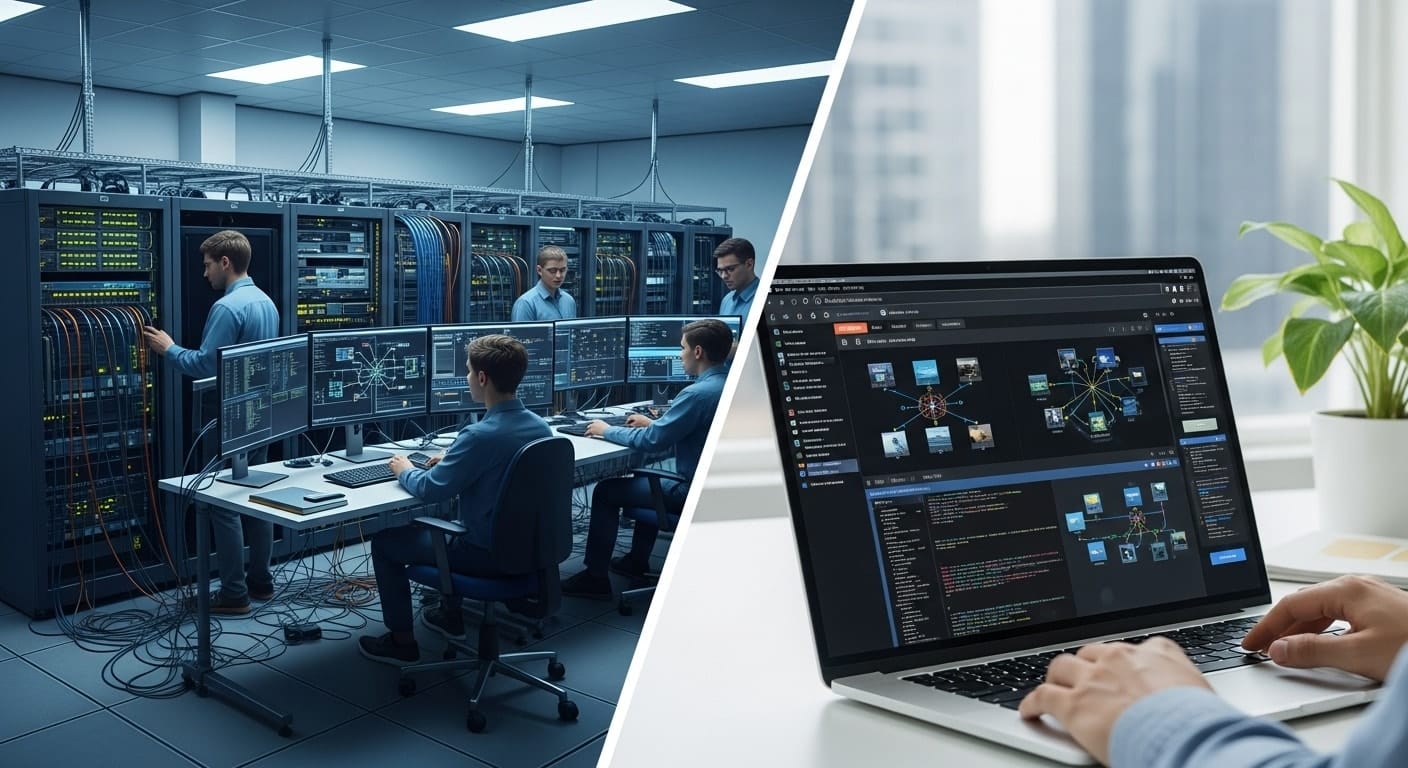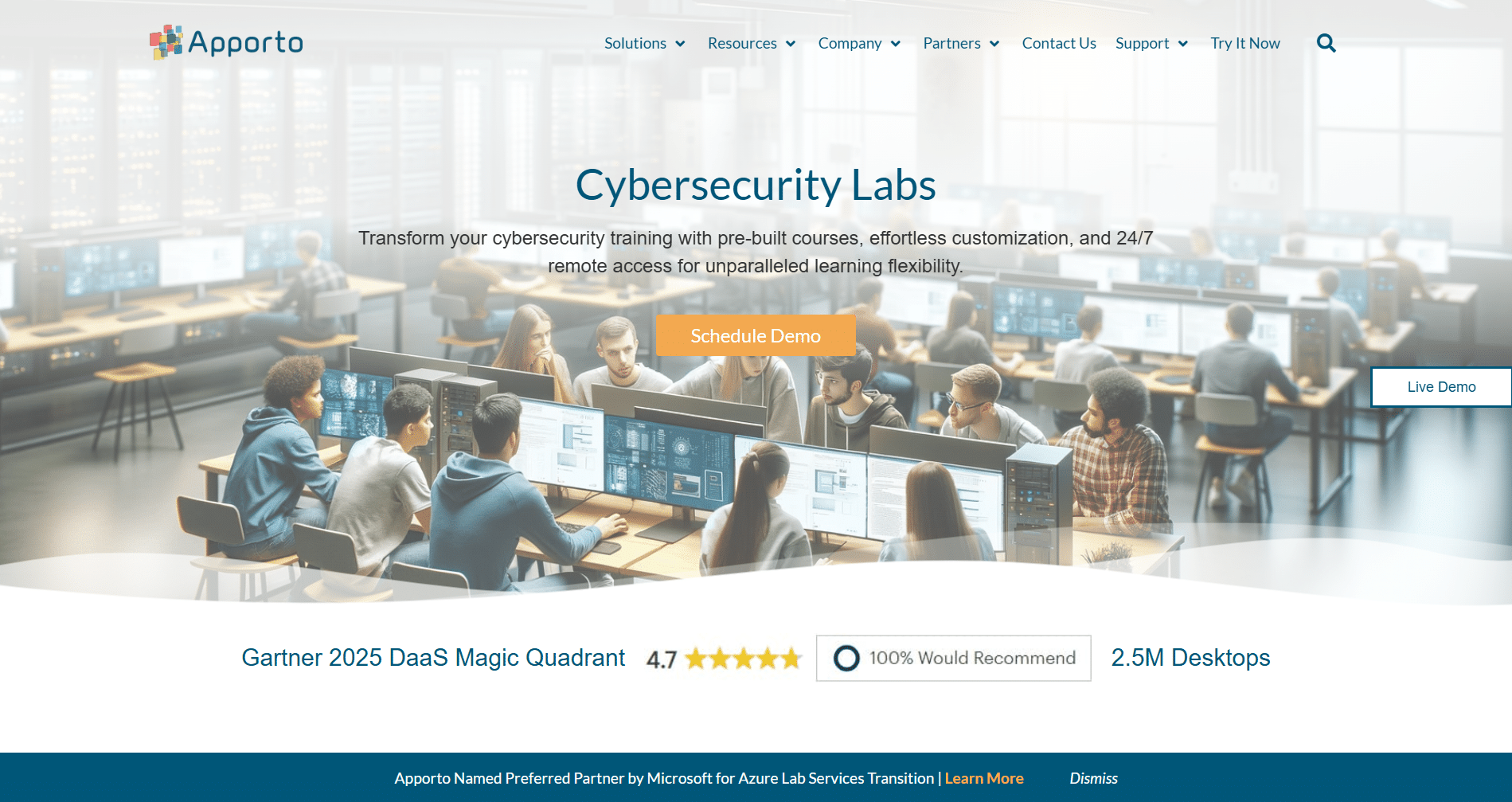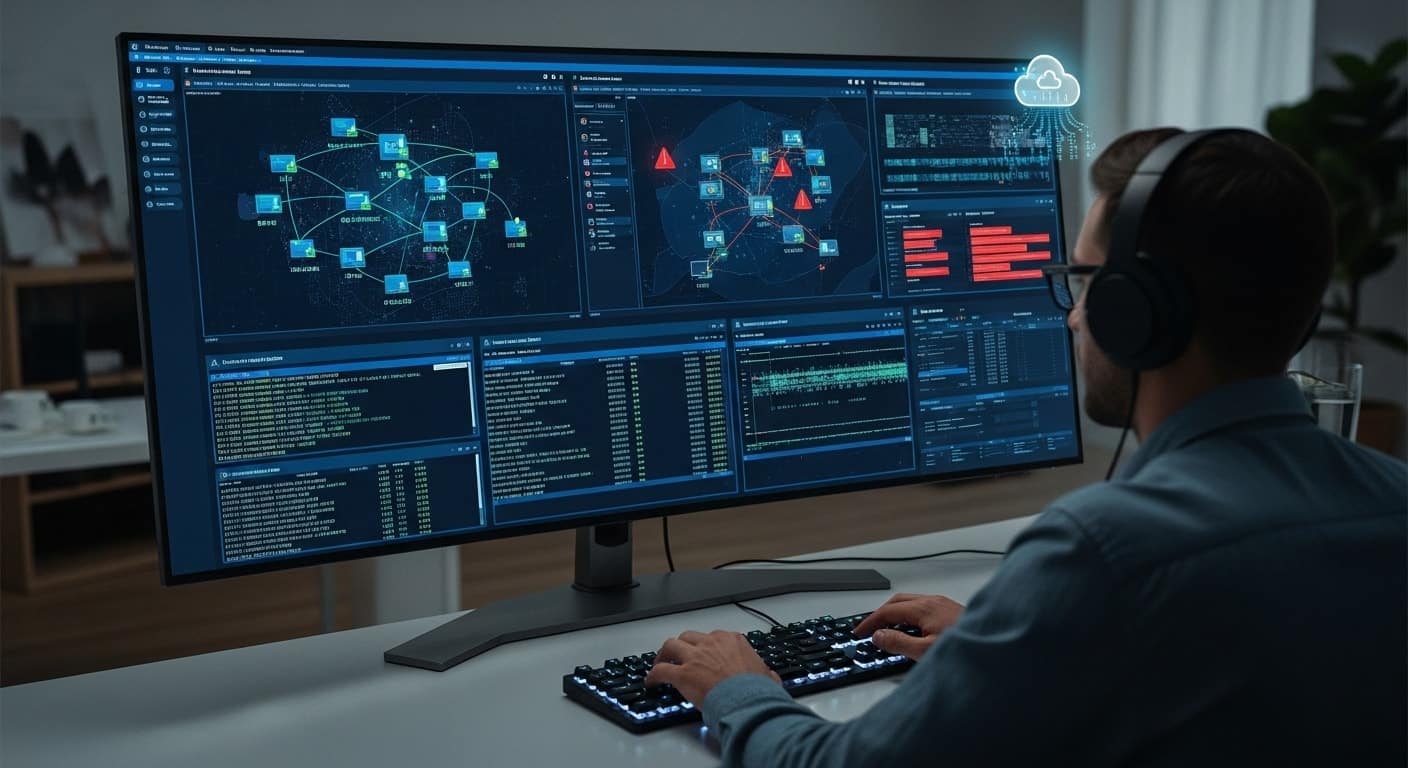You step into a world where cybersecurity training no longer depends on hardware or fixed lab space, and the shift carries real implications for how you learn.
A virtual cybersecurity lab gives you a controlled environment that mirrors the systems you will face in practice, yet it removes the usual barriers of cost, location, and upkeep.
You get room to experiment, to make mistakes, and to see how digital defenses behave under pressure. The appeal is not just convenience but the clarity that comes from working directly with realistic tools and networks.
As you move through this guide, you will see how these environments reshape skill building and why they are becoming essential for anyone sharpening their security capabilities.
What Is a Virtual Cybersecurity Lab and How Does It Work?
A virtual cybersecurity lab is a cloud-hosted environment that gives you the freedom to explore, test, and build cybersecurity skills in a safe and fully contained space.
Instead of relying on physical hardware or campus labs, everything runs through the cloud using virtual machines, web browsers, and secure access protocols. These labs are designed to mirror the real world — complete with simulated networks, configurable systems, and the same security tools you’d use in a professional setting. To learn more about the transformation and future of university computer labs, explore this in-depth article.
You’re not just reading about threats or memorizing theory — you’re working directly with tools like firewalls, malware scanners, and packet analyzers. The environments are sandboxed, which means any mistakes or experiments are completely isolated from live infrastructure.
That makes these labs perfect for training, especially in industries where hands-on experience is essential. So, what makes them better than traditional training labs? Let’s explore how virtual labs improve accessibility, reduce cost, and deliver real-world impact.
Why Are Virtual Cybersecurity Labs Better Than Traditional Labs?

Traditional cybersecurity labs often require physical space, on-site hardware, and significant IT oversight to maintain. In contrast, virtual cybersecurity labs eliminate these logistical hurdles. Everything is delivered through your browser, which means you can access a full training environment without installing software or setting up local machines.
This cloud-native approach makes labs inherently scalable and accessible. Whether you’re managing a global training program or assigning coursework to a remote class, virtual labs let you deliver hands-on cybersecurity training instantly — no matter where your learners are located. There’s no waiting for lab time, no patching devices, and no dealing with hardware failures.
Beyond convenience, virtual labs also save time and money. Without physical equipment to maintain, costs drop sharply, and the flexibility to customize environments reduces technical overhead. It’s a model that works just as well for independent learners as it does for enterprise teams and academic institutions.
Next, let’s look at what types of hands-on training these labs actually make possible.
What Types of Hands-On Training Can You Do in a Cybersecurity Lab?

A virtual cybersecurity lab isn’t just a theoretical exercise — it’s a dynamic, practice-driven environment. You can perform malware analysis, identify vulnerabilities, and engage in threat modeling, all within a secure, isolated system. These labs allow you to simulate cyber attacks, then test your defenses in real time, gaining practical experience with everything from firewall configuration to phishing mitigation.
You also get to use actual security tools found in enterprise networks, giving you familiarity with real-world workflows. The controlled setup makes it possible to explore more advanced tasks, such as incident response, penetration testing, and even data recovery after a simulated breach.
Through structured repetition and variation, these exercises reinforce crucial cybersecurity concepts. The result isn’t just knowledge — it’s skill. You’re not memorizing best practices; you’re applying them, adapting to challenges, and learning how to respond under pressure. That kind of hands-on training builds confidence that theory alone never will.
Who Needs a Virtual Cyber Lab Today?
With the rise in cyber threats and remote access needs, the demand for virtual cybersecurity labs is no longer limited to universities. Students studying cybersecurity or IT networking use these labs to gain real-world skills from day one, without needing expensive hardware or physical lab space.
Educators benefit just as much. They can design scalable, interactive courses or bootcamps that match modern industry requirements — all delivered through the browser. For organizations, these labs offer an efficient way to train staff on emerging threats, tools, and compliance protocols, especially when traditional, in-person training isn’t feasible.
IT leaders can also use virtual labs to guide team development with tailored learning paths, helping employees upskill quickly and effectively. And for remote-first teams, the value is clear: secure, on-demand access to lab environments from anywhere in the world. No shipping equipment. No IT bottlenecks. Just practical, accessible training that keeps your team sharp.
What Should You Look for in a Cybersecurity Training Platform?

Choosing the right cybersecurity training platform can significantly affect the success of your program. At its core, the platform should offer hands-on labs that allow you to engage with real cybersecurity tools and test defenses against realistic threat scenarios. The more authentic the environment, the more effective the learning.
Look for platforms with built-in curriculum aligned with industry certifications and learning standards. Pre-loaded exercises, modular learning paths, and structured lab progression help keep training focused and measurable. A browser-based platform is ideal — it simplifies deployment and enables remote access without technical hurdles.
Support for multiple operating systems, including Linux and Windows, adds flexibility to match real-world environments. Finally, features like user monitoring, session control, and live collaboration tools allow educators and team leads to guide, support, and assess users in real time.
With the right platform in place, learners can begin turning cybersecurity theory into working knowledge.
How Do Cyber Labs Help Build Practical Cybersecurity Skills?
The gap between learning about cybersecurity and actually doing it is often wide. Virtual cybersecurity labs bridge that gap by turning theory into applied knowledge. Instead of memorizing protocols or reading about exploits, you’re practicing them — in a safe, structured, and repeatable environment.
These labs let you simulate attack scenarios and immediately shift into threat mitigation. You can test firewall rules, encrypt data, or configure network security, all while troubleshooting issues as they happen. This kind of hands-on learning makes complex topics stick and helps build mental models that transfer into real-world problem-solving.
Alongside technical skills, labs sharpen your critical thinking and reaction time. You learn how to assess risk, isolate issues, and respond to unfamiliar situations — the same skills that matter during a live incident. Whether you’re a beginner or advancing toward certification, cyber labs meet you where you are and grow with you.
How Secure Are Virtual Cybersecurity Labs for Training?

Security is the foundation of any cybersecurity lab, and virtual environments are designed with that priority in mind. These labs run in isolated, cloud-based environments, completely separate from your organization’s production systems. That means you can safely simulate malware, attacks, and misconfigurations without real-world consequences.
Built-in safeguards prevent any accidental spillover, and granular access controls allow you to assign roles, manage permissions, and monitor usage. This ensures both safety and accountability, whether you’re training students or professionals.
Labs are also updated regularly to stay aligned with the latest vulnerabilities and cyber threats, giving you a secure, current platform for every session.
How Do You Start a Virtual Cybersecurity Training Program?
Launching a virtual cybersecurity training program begins with selecting a platform that offers structured courses, hands-on labs, and flexible training options. Make sure it aligns with essential industry certifications like CompTIA, CISSP, or Security+ to ensure credibility and direction.
Next, customize the experience by mapping labs to your team’s actual challenges — whether that’s phishing defense, network segmentation, or incident response. Enable real-time collaboration, instructor monitoring, and integrated feedback tools to create a more engaging environment.
Lastly, ensure the platform provides cloud-based access so that learners can participate from anywhere — without sacrificing security or control.
Why Are Virtual Cyber Labs the Future of Cybersecurity Education?
The future of cybersecurity education lies in environments that are flexible, interactive, and fully accessible. Virtual cyber labs eliminate the need for expensive infrastructure while expanding reach to learners across locations and time zones. They support hands-on training that goes beyond theory — giving students and teams the chance to test, break, and fix in safe environments.
As cyber threats evolve, so must training. These labs help your team respond faster, smarter, and with greater confidence. Continuous updates, real-time feedback, and accessible cloud delivery make them a powerful tool for skill development at every level.
Want to Build Your Own Cybersecurity Lab in the Cloud?

Explore how Apporto’s Cybersecurity Labs help you deliver secure, hands-on cybersecurity training without the overhead of physical infrastructure. From drag-and-drop virtual machine setup to pre-built learning paths and sandboxed environments, everything is ready to launch from your browser.
Whether you’re teaching students or training staff, Apporto makes scalable, cloud-based labs easy to deploy and even easier to manage. Try Apporto’s Virtual Cyber Lab Now
Final Thoughts
Virtual cybersecurity labs are more than just a convenience, they’re changing how cybersecurity skills are taught and retained. By combining scalability, real-world tools, and immersive learning, they give you everything traditional labs often lack.
Theory has its place, but without practical experience, it falls short in the face of real threats. These labs fill that gap, offering structured training that’s as dynamic as the field itself.
If you’re serious about upskilling your team or students, now is the time to explore guided, flexible training platforms that turn knowledge into action — and labs into lasting capability. Get started with Apporto today!
Frequently Asked Questions (FAQs)
1. What is a virtual cybersecurity lab used for?
A virtual cybersecurity lab provides a secure, browser-based environment where you can safely simulate, explore, and respond to real-world cyber threats using hands-on tools and guided training exercises.
2. Are virtual labs good for beginners?
Yes. Beginners can use these labs to learn essential cybersecurity skills without risk. They offer a safe space to practice techniques, test software, and build confidence from the ground up.
3. What kind of exercises are in a cyber lab?
Labs often include malware testing, password cracking, threat detection, firewall setup, encryption tasks, and incident response drills — all designed to simulate real cybersecurity challenges.
4. Can these labs be used in employee training?
Absolutely. Organizations use cyber labs to train employees on identifying threats, managing breaches, and handling real-time attacks. It’s a scalable, repeatable way to keep teams sharp and compliant.
5. How do virtual labs stay secure?
Labs are isolated in cloud-based environments with built-in access controls, updated software, and role-based permissions — ensuring no overlap with live systems or sensitive organizational data.


